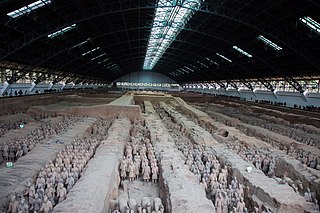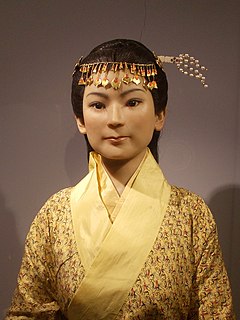 W
WChariot burials are tombs in which the deceased was buried together with their chariot, usually including their horses and other possessions. An instance of a person being buried with their horse is called horse burial.
 W
WThe term Chinese pyramids refers to pyramidal shaped structures in China, most of which are ancient mausoleums and burial mounds built to house the remains of several early emperors of China and their imperial relatives. About 38 of them are located around 25 kilometres (16 mi) – 35 kilometres (22 mi) north-west of Xi'an, on the Guanzhong Plains in Shaanxi Province. The most famous is the Mausoleum of the First Qin Emperor, northeast of Xi'an and 1.7 km west of where the Terracotta Army was found.
 W
WHanging coffins are coffins which have been placed on cliffs. They are practiced by various cultures in China, Indonesia, and the Philippines.
 W
WThe Li-Lao bronze drums or Heger type II drums are a type of ancient bronze drums found in Southern China and Northern Vietnam invented and used by Tai-Kadai-speaking ethnic groups who were known to Chinese as Lǐ (俚) or Lǎo (獠) and who historically inhabited the Red River Delta from the 3rd to 8th century AD and later the Muong people, an ethnic minority in Northern Vietnam, from 10th to 12th century. Classified by Franz Heger as type II to distinguish with the Dian-Dong Son drums or Heger type I, the Karen drum or Heger type III. Li-Lao drums were found in Guangdong, Guangxi, the Red River Delta and the Muong hills.
 W
WThe Liujiang men are among the earliest modern humans found in East Asia. Their remains were discovered in the Tongtianyan Cave (通天岩) in Liujiang, Guangxi, China.
 W
WThe Longyou Caves, also called the Xiaonanhai Stone Chambers, are a group of 24 artificial sandstone caverns located at Fenghuang Hill, near the village of Shiyan Beicun on the Qu River in Longyou County, Quzhou prefecture, Zhejiang province, China. Created more than 2,000 years ago, they were not recorded in any historical documents and were rediscovered by farmers in 1992.
 W
WOracle bones are pieces of ox scapula and turtle plastron, which were used for pyromancy – a form of divination – in ancient China, mainly during the late Shang dynasty. Scapulimancy is the correct term if ox scapulae were used for the divination, plastromancy if turtle plastrons were used.
 W
WPeking Man is a subspecies of H. erectus which inhabited the Zhoukoudian Cave of northern China during the Middle Pleistocene. The first fossil, a tooth, was discovered in 1926, and the Zhoukoudian has since become the most productive H. erectus site in the world. Peking Man was instrumental in the foundation of Chinese anthropology, and fostered an important dialogue between Western and Eastern science for decades to come. The fossils became the centre of anthropological discussion, and were classified as a direct human ancestor, propping up the Out of Asia hypothesis that humans evolved in Asia. Peking Man also played a vital role in the restructuring of the Chinese identity following the Chinese Communist Revolution, and was intensively communicated to working class and peasant communities to introduce them to Marxism and science. As a consequence of the former, early models of Peking Man society strongly leaned towards communist or nationalist ideals, leading to discussions on primitive communism and polygenism. This produced a strong schism between Western and Eastern interpretations, especially as the West adopted the Out of Africa hypothesis by the late 20th century, and Peking Man's role in human evolution diminished as merely an offshoot of the human line. Now that the hypothesis is ubiquitous, Peking Man interbreeding with human ancestors is frequently discussed especially in Chinese circles.
 W
WShaanxi Provincial Institute of Archaeology is the official archaeological institute of China's Shaanxi Province. It operates an archaeological museum in Yanta District of Xi'an with a collection of more than 140,000 objects including bronzes, statues, pottery, porcelain, and books. There are nearly 130 thousand books in the library of the institute, making it one of the largest collections of books in the field of literature and archaeology in China.
 W
WShang archaeology is concerned with the archaeological evidence for the Shang dynasty. Choice of excavation sites and interpretation of finds have been heavily influenced by the textual historical record.
 W
WThe Terracotta Army is a collection of terracotta sculptures depicting the armies of Qin Shi Huang, the first Emperor of China. It is a form of funerary art buried with the emperor in 210–209 BCE with the purpose of protecting the emperor in his afterlife.
 W
WThe three hares is a circular motif or meme appearing in sacred sites from the Middle and Far East to the churches of Devon, England, and historical synagogues in Europe. It is used as an architectural ornament, a religious symbol, and in other modern works of art or a logo for adornment, jewelry, and a coat of arms on an escutcheon. It is viewed as a puzzle, a topology problem or a visual challenge, and has been rendered as sculpture, drawing, and painting.
 W
WWang Yuanlu was a Taoist priest and abbot of the Mogao Caves at Dunhuang during the early 20th century. He is credited with the discovery of the Dunhuang manuscripts. He engaged in the restoration of the site which he funded with the sale of numerous manuscripts to Western and Japanese explorers.
 W
WWushan Man is a set of fossilised remains of an extinct, undetermined non-hominin ape found in central China in 1985. The remains are dated to around 2 million years ago and were originally considered to represent a subspecies of Homo erectus.
 W
WXin Zhui, also known as Lady Dai or Marquise of Dai, was married to Li Cang (利蒼), the Marquis of Dai and Chancellor of Changsha Kingdom, during the Western Han dynasty of ancient China. Her tomb and exceptionally well preserved remains were discovered in 1968, alongside hundreds of valuable artifacts and documents, inside a hill known as Mawangdui, in Changsha, Hunan, China. Her body and belongings are currently under the care of the Hunan Museum, which has allowed occasional international exhibits.
 W
WYang Zhifa is one of the discoverers of the Terracotta Army. For many years, he worked in a small souvenir shop within the museum of the Mausoleum of the First Qin Emperor, where he was signing books sold to the tourists.
 W
WYuanmou Man is a subspecies of H. erectus which inhabited the Yuanmou Basin in the Yunnan Province, southwestern China, roughly 1.7 million years ago. It is the first fossil evidence of humans in China, though they probably reached the region by at least 2 million years ago. Yuanmou Man is known only from two upper first incisors presumed to have belonged to a male, and a partial tibia presumed to have belonged to a female. The female may have stood about 123.6–130.4 cm in life. These remains are anatomically quite similar to those contemporary early Homo in Africa, namely H. habilis and H. (e?) ergaster.